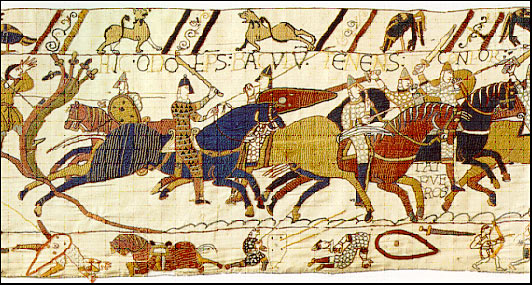| This article is the copyright of Brian Oldham and is produced here with his kind permission | |||
|
|||
|
Odo, who was born in the early 1030s, was the son of Herleve by Herluin, vicomte of Conteville. His mother was the daughter of Fulbert, a tanner of Falaise who had been married off to his father by Robert, Duke of Normandy. The couple had at least one other child, Robert, who became Count of Mortain. Prior to her marriage Herleve began a relationship with Robert of Normandy when both were probably about seventeen years old. It appears to have lasted for sometime and resulted in the birth of William in 1028 at Falaise and possibly also a daughter. William was destined to become Duke of Normandy and King of England. Thus Odo was a half-brother of William the Conqueror. William made Odo Bishop of Bayeux in late 1049 or early 1050. This was undoubtedly a political appointment at a time when William was attempting to consolidate his hold on Normandy after his victory over the rebels at Val-es-Dunes in 1047. Little is known of Odo’s early life as bishop but he was later responsible for the rebuilding of Bayeux cathedral and probably commissioned the Bayeux Tapestry. The cathedral and tapestry were dedicated in 1077. Odo took an important part in the conquest of England. He was heavily involved in the planning and execution of the crossing and provided 100 ships for the invasion fleet. He accompanied William to England in 1066 and the Bayeux Tapestry depicts him in council with William and Robert of Mortain planning the coming battle. Odo was present at the Battle of Hastings and is shown on the tapestry holding a mace and rallying troops. After the battle Odo was made Earl of Kent. It was in this role that he was granted the manor of Gayhurst as tenant-in-chief from William. His landholdings were vast covering twenty-two counties in south and east England. The only person holding more land than Odo was William. His chief residences were Dover, Rochester, Deddington (Oxfordshire) and Snettisham (Norfolk). He probably spent little time in any one place and witnessed all the major events of William’s reign. When William returned to Normandy in March 1067 he left Odo and William fitz Osbern, Earl of Hereford, in control of England. Odo’s main tasks were to establish control of the south-east and defend the Channel coast and links across to Normandy. The English were certainly not enamoured of the two men who set about building castles to control the local population. Odo played a major part in putting down a rebellion led by Earls Ralph and Roger in 1075. In 1080 William had problems along the Scottish border which resulted in the murder of the Bishop of Durham. He sent his eldest son, Robert of Normandy, and Odo to deal with the matter. It seems likely that Odo’s authority in England was second only to that of the king. However, in 1082 William quarrelled with Odo and imprisoned him for life in Rouen. According to three independent twelfth-century chroniclers Odo was preparing to take knights to Italy in support of his claim to the papacy! Odo appears to have retained his possessions, as at the time of the Domesday survey in 1086 he was the largest landowner in England after the king. He was only released by William II after pressure on his father by Robert of Mortain succeeded in swaying the old king in his dying days the following year. From William II’s point of view the release of Odo was a mistake. The year following his coronation Odo led a rebellion in favour of Robert of Normandy. Interestingly he was supported this time by his brother, Robert of Mortain, and the ‘old guard’ of the conquest. A virtual civil war ensued and it was only the non-appearance of Robert in England that ended it. Odo was besieged, first at Pevensey and then at his base of Rochester. He was finally defeated and exiled for life. Back in Normandy Odo became a staunch ally of his nephew, Duke Robert. In 1095 Odo was among the Norman bishops at the Council of Clermont when Pope Urban II preached the First Crusade. In September 1096 Odo joined the army of Robert of Normandy. He visited Rome and met the Pope. When the crusader army stopped for Christmas in southern Italy, Odo crossed to Sicily to meet with Count Roger the Great. It was there in January 1097 that he died. He was buried in Palermo Cathedral. Although Odo never married he had one son, John of Bayeux, who later became chaplain to Henry I. Odo has been described as ‘an extravagant, larger-than-life character’ in whom ‘vices were mingled with virtues’. He was an effective bishop and regent of England and also a patron of the arts and writing. Whether he ever set foot in Gayhurst is debatable.
|
|||
|
|
